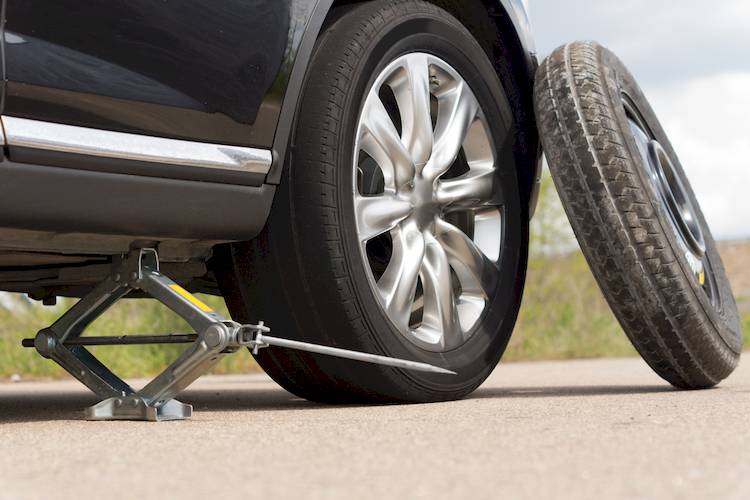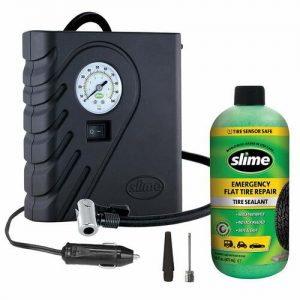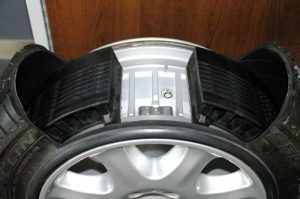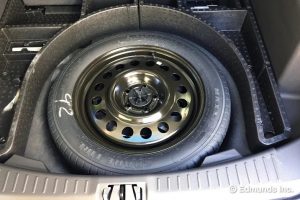

Picture this: you’re in rush to get somewhere then hear a loud pop and the tire pressure light turns on. As you inspect the tires, you notice the culprit: a nail. You think to yourself “no big deal, I have a spare.” But when you reach into the trunk, there is no spare tire. In its place, you find a small device with a gauge and a power plug. It’s a tire repair kit. As newer car manufacturers are starting to provide these kits instead of a spare, learning how to use one of these is extremely valuable.
Many automakers are favoring tire repair kits over spares because they take up very little space and reduce vehicle weight. Decades ago, almost every car came with a spare tire. But fuel economy requirements, trunk space considerations, and the dangers involved in setting up a jack on the side of a road prompted automakers to shift toward tire repair kits, run-flat tires, or temporary spares (donuts).
The worst time to find out about the different types of spares is when you have a flat. It’s better to learn about the pros and cons of various spares during your search for a new car! Let’s take a closer look at the pros and cons of each spare tire type as well as tire repair kits.
Tire Repair Kits
A tire repair kit also called an inflator or mobility kit takes up the least amount of space in the trunk. Instead of a spare, there’s a kit consisting of an air compressor with an attached hose and an integrated bottle of sealant.

In the event of a flat tire, you attach the inflator-kit hose to the valve stem of the tire. When you turn on the unit, it injects the sealant into the tire. Then you use the compressor to inflate the tire. The advantage of an inflator kit is that you don’t have to jack up the car or remove the tire.
However, the kit can only be used if the puncture is on the tire’s tread and is not larger than 4 millimeters (about the size of a pencil eraser). If the puncture is on the sidewall or is larger than 4 mm, you can’t use the kit. Also, you can’t use the kit if the tire has separated from the wheel. In those cases, you need to call roadside assistance and have the vehicle towed down to Luke’s Auto Service or the nearest auto repair shop!
If you are able to repair your tire, for the time being, remember to restock your kit with a new bottle of sealant since the repair kit holds only enough fluid for one application!
Run-Flat Tires
Vehicles with run-flat tires typically have no spare or repair kit. Run-flats have reinforced sidewalls that allow them to operate with little to no tire pressure.
 Once a run-flat tire has been punctured and lost its air pressure, the vehicle’s tire-pressure monitoring system will notify you that the tires are low which means the vehicle is in “run-flat mode.” You will have to keep your speed under 50 mph until you are able to find a tire shop or service station.
Once a run-flat tire has been punctured and lost its air pressure, the vehicle’s tire-pressure monitoring system will notify you that the tires are low which means the vehicle is in “run-flat mode.” You will have to keep your speed under 50 mph until you are able to find a tire shop or service station.
Pros:
- You can drive on a flat tire: You can keep driving on a flat at about 50 mph for about 100 miles (check the owner’s manual for exact figures). This means you don’t have to get out of the car in the cold, the rain, or onto a busy highway!
- Better stability after a blowout: Because this tire can support the vehicle without air, a sudden deflation results in less weight transfer and tread destabilization.
- Lower vehicle weight: With the spare tire and tire repair tools eliminated, vehicle weight decreases.
Cons:
- No spare: Vehicles equipped with run-flats do not carry a spare wheel and tire, which means they don’t have a jack or kit either.
- Reduced tread wear: A side effect of the softer compound on these tires is shorter tread life which means they need to be replaced more often than standard tires.
- Hard to tell if it is low on air: Since the construction is stiffer, the sidewalls do not bulge if the air pressure is low. Therefore, it is critical to have a tire pressure monitoring system and check your tire pressure frequently.
- Harsher ride: The stiff sidewalls that make a run-flat work also result in a harsher ride.
Next, we will talk about temporary spares. These tires are the most common and offer the best balance between size and usability.
Temporary Spares
Temporary spares or “donuts” are the most common choice for automakers. They are smaller than the vehicle’s other tires, take up less trunk space, and are designed to reduce weight in your vehicle.
Since they are not equal to your regular tires, they are only meant to be driven a short distance. Most temporary spares are limited to a speed of 50 mph.
Pros:
- Small and lightweight: Can be easily stored in your vehicle without taking up too much space/ decreasing your fuel economy.
- Less expensive to replace
- Quick Fix: these tires are easy to change out
Cons:
- Short-term use only: A good rule of thumb is a donut spare should not be driven more than 70 miles and no faster than 50 mph.
- Not durable: A temporary spare can not take the abuse of driving as well as a regular tire. That is why you want to have them replaced as soon as possible.
- Cannot be repaired: The rubber is of inferior quality compared to a regular tire. The tread isn’t as deep and the rubber isn’t as thick. So even if you managed to plug the tire, most likely, it wouldn’t hold.
Spare tires seem to be such a simple but overlooked aspect of your vehicle. Most people don’t start to ask questions until they actually need to use one! It is important to research your vehicle and understand what spare (if any) it is equipped with before getting a flat! Always remember that if you have any questions or need to get your vehicle towed because it has a flat, Luke’s Auto Service in Verona, New Jersey is always here to help!
Images:
References:
